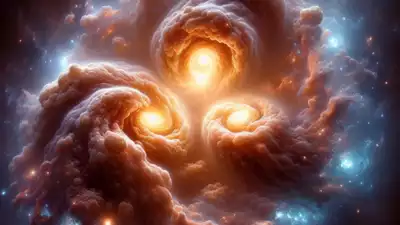- Introduction
- The Big Bang and the Formation of the Universe
- The Cosmic Dark Ages and Reionization
- Observing the Earliest Galaxies: Technological Advancements
- Discovering the First Galaxies
- Implications for Cosmology
- Understanding Reionization
- Challenges and Future Directions
- The Human Element: The Role of Astronomers and Engineers
- Educational and Cultural Impact
- Conclusion
- Supportive Sources:
Introduction
The universe is a vast, mysterious expanse that has intrigued humanity for millennia. One of the most profound questions in cosmology is how galaxies, the building blocks of the universe, first formed. Recent advancements in astronomical technology have enabled scientists to observe the birth of the universe’s earliest galaxies for the first time. This monumental discovery offers unprecedented insights into the processes that shaped the cosmos shortly after the Big Bang and has significant implications for our understanding of the universe’s evolution.

The Big Bang and the Formation of the Universe
To understand the significance of observing the earliest galaxies, it is essential to start with the Big Bang, the event that marks the beginning of the universe. Approximately 13.8 billion years ago, the universe began as an infinitely small, hot, and dense point. This singularity expanded rapidly in an event known as the Big Bang, leading to the creation of all matter, energy, space, and time.
In the first few moments after the Big Bang, the universe was in a state of extreme energy and temperature. As it expanded, it cooled, allowing quarks and gluons to form protons and neutrons. These particles combined to form the first atomic nuclei in a process called nucleosynthesis, occurring within the first few minutes of the universe’s existence. However, it took around 380,000 years for the universe to cool enough for electrons to combine with nuclei, creating neutral hydrogen atoms. This period, known as recombination, allowed photons to travel freely, rendering the universe transparent and giving rise to the cosmic microwave background radiation that we observe today.
The Cosmic Dark Ages and Reionization
Following recombination, the universe entered a period often referred to as the “Cosmic Dark Ages.” During this time, the universe was filled with neutral hydrogen gas and was devoid of any light-emitting objects. This lasted for several hundred million years until the first stars and galaxies began to form, igniting the universe once again. The formation of these early galaxies played a crucial role in ending the Cosmic Dark Ages through a process called reionization.
Reionization occurred when the light from the first stars and galaxies ionized the surrounding hydrogen gas, turning it from neutral to ionized once more. This process created the ionized intergalactic medium that exists today and allowed light to travel freely through the universe. Understanding reionization is vital for cosmologists because it marks the transition from a dark, opaque universe to the luminous cosmos we see now.
Observing the Earliest Galaxies: Technological Advancements
The ability to observe the birth of the universe’s earliest galaxies has been made possible by remarkable advancements in astronomical technology. The Hubble Space Telescope (HST), launched in 1990, has been instrumental in deep-space observations. Its successor, the James Webb Space Telescope (JWST), launched in December 2021, has taken this capability to unprecedented levels.
The James Webb Space Telescope
The JWST is the most powerful space telescope ever built, designed to look farther into the universe’s past than any previous telescope. It operates primarily in the infrared spectrum, which is crucial for observing distant galaxies. As light from these galaxies travels through the expanding universe, it is redshifted into the infrared spectrum. The JWST’s advanced instruments are capable of detecting this faint, redshifted light, allowing astronomers to peer back in time to when the first galaxies were forming.
Equipped with a 6.5-meter primary mirror and sophisticated instruments such as the Near Infrared Camera (NIRCam) and the Mid-Infrared Instrument (MIRI), the JWST can capture high-resolution images and spectra of early galaxies. These observations provide critical data on the composition, structure, and star formation activities of these primordial objects.

Discovering the First Galaxies
In recent observations, the JWST has captured images of galaxies that formed less than 400 million years after the Big Bang. These galaxies are the earliest known to exist and provide a glimpse into the universe’s formative years.
Characteristics of the Earliest Galaxies
The earliest galaxies observed are relatively small compared to modern galaxies, with masses ranging from a few million to a few billion times that of the Sun. They are characterized by high rates of star formation and are composed predominantly of young, massive stars. These stars are significantly more luminous and hotter than those found in later galaxies, contributing to the reionization of the universe.
One of the key findings from the JWST’s observations is the discovery of galaxies with mature structures, such as well-defined disks and central bulges, much earlier in the universe’s history than previously thought. This challenges existing models of galaxy formation, which suggested that such structures would take billions of years to develop.
Spectroscopic Analysis
Spectroscopic analysis of the light from these early galaxies reveals important information about their composition and star formation activities. The presence of heavy elements (elements heavier than hydrogen and helium) indicates that these galaxies have undergone multiple generations of star formation, as these elements are produced in the cores of stars and dispersed into the interstellar medium through supernova explosions.
The detection of ionized oxygen and hydrogen lines in the spectra of these galaxies provides evidence for intense star formation and high-energy processes occurring within them. These observations are consistent with theoretical predictions of Population III stars, the first generation of stars formed in the universe, which were massive, short-lived, and capable of producing the first heavy elements.
Implications for Cosmology
The observation of the universe’s earliest galaxies has profound implications for cosmology, offering new insights into the processes that shaped the early universe and the formation of cosmic structures.
Refining Models of Galaxy Formation
The discovery of mature galaxy structures in the early universe challenges existing models of galaxy formation and evolution. Traditional models posited that galaxies formed gradually through hierarchical merging, where small structures merged over time to form larger galaxies. However, the presence of well-formed disks and bulges in these early galaxies suggests that galaxy formation may have occurred more rapidly and efficiently than previously thought.
These observations necessitate a reevaluation of galaxy formation theories, incorporating mechanisms that can account for the rapid assembly and evolution of galaxies in the early universe. This may involve new insights into the role of dark matter, gas accretion, and feedback processes in shaping galaxies.
Understanding Reionization
Observing the earliest galaxies provides critical data for understanding the reionization process. By studying the light from these galaxies, astronomers can estimate the rate of ionizing photon production and the contribution of these early galaxies to the reionization of the universe. This helps to constrain models of how and when reionization occurred and the types of sources responsible for this transformation.
Formation of Heavy Elements
The presence of heavy elements in the earliest galaxies has implications for our understanding of nucleosynthesis and the chemical evolution of the universe. These elements are crucial for the formation of planets and life, indicating that the building blocks of complex structures were in place very early in the universe’s history. This discovery also informs models of star formation and the life cycles of the first stars.
Challenges and Future Directions
While the observation of the universe’s earliest galaxies marks a significant milestone in cosmology, it also presents several challenges and opens new avenues for research.
Observational Challenges
Observing the faint, distant light from the earliest galaxies is inherently challenging. The JWST’s capabilities are unparalleled, but even it is limited by the sensitivity and resolution required to detect the most distant objects. Future telescopes, such as the proposed next-generation space telescopes, will need to build on the JWST’s success, offering even greater sensitivity and resolution to push the observational frontier further back in time.
Theoretical Challenges
The discovery of mature galaxy structures in the early universe challenges existing theoretical models. This necessitates the development of new theories or the refinement of existing ones to account for the rapid formation and evolution of galaxies. This involves complex simulations of cosmic structure formation, incorporating detailed physics of gas dynamics, star formation, and feedback processes.
Future Observations
Future observations will aim to identify even earlier galaxies and to study the formation of the first stars and black holes. The planned launch of the Nancy Grace Roman Space Telescope, with its wide-field infrared survey capabilities, will complement the JWST by surveying large areas of the sky, identifying new targets for detailed study. Additionally, ground-based telescopes like the Extremely Large Telescope (ELT) will provide high-resolution imaging and spectroscopy, enabling detailed studies of the earliest galaxies’ physical properties.
The Human Element: The Role of Astronomers and Engineers
The groundbreaking observations of the earliest galaxies are the result of decades of work by astronomers, engineers, and scientists. The development, launch, and operation of the JWST involved the collaboration of thousands of individuals across the globe. Their efforts underscore the importance of international cooperation and the pursuit of knowledge for the advancement of science.
The Development of the JWST
The JWST project was a collaborative effort involving NASA, the European Space Agency (ESA), and the Canadian Space Agency (CSA). The telescope’s development spanned over two decades, with significant contributions from scientists and engineers in various countries. The project’s complexity required overcoming numerous technical challenges, such as the design and construction of the telescope’s large, segmented mirror and its sophisticated cooling system.
The Role of Astronomers
Astronomers played a crucial role in defining the scientific goals of the JWST and in planning its observations. Teams of scientists proposed and prioritized observation programs, focusing on key questions about the early universe. Once the telescope began operations, astronomers analyzed the data, interpreting the observations to uncover new insights about the formation and evolution of galaxies.
Educational and Cultural Impact
The observation of the universe’s earliest galaxies has a profound impact beyond the scientific community, inspiring public interest in astronomy and cosmology. These discoveries capture the imagination, offering a glimpse into the distant past and our cosmic origins.
Public Engagement and Education
Public interest in space exploration and astronomy has been significantly boosted by the JWST’s discoveries. Educational programs, documentaries, and public lectures have brought the excitement of these discoveries to a broader audience. By making complex scientific concepts accessible, these efforts help to foster a greater appreciation for science and inspire the next generation of astronomers and engineers.
Cultural Significance
The discovery of the universe’s earliest galaxies also has cultural and philosophical implications. It prompts us to reflect on our place in the universe and the origins of the cosmic structures that eventually led to the formation of stars, planets, and life. This sense of connection to the cosmos enriches our understanding of human existence and our quest for knowledge.
Conclusion
The observation of the birth of the universe’s earliest galaxies represents a monumental achievement in the field of cosmology. Enabled by advanced astronomical technology, particularly the James Webb Space Telescope, these discoveries offer unprecedented insights into the processes that shaped the early universe. From challenging existing models of galaxy formation to providing crucial data for understanding reionization, the implications of these observations are profound.
As we continue to explore the cosmos, future telescopes and observational techniques will push the boundaries of our knowledge even further. The collaborative efforts of scientists and engineers, combined with public interest and educational outreach, ensure that the quest to understand the universe’s origins will continue to inspire and enlighten humanity for generations to come.
In the grand tapestry of the cosmos, the birth of the earliest galaxies marks a crucial chapter in the story of the universe. As we uncover the secrets of these ancient structures, we not only learn about the universe’s past but also gain insights into the processes that led to the formation of galaxies, stars, and ultimately, life itself. The journey of discovery continues, driven by the human spirit of curiosity and the desire to understand our place in the vast expanse of the cosmos.

